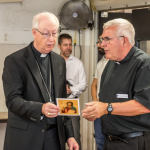More than 30 years ago, Lloyd Sweet entered a confessional after being away from his faith for decades. To this day, he remembers the profound relief he felt when the priest hearing his confession simply responded, “Welcome home.”
That compassion and the wiping away of a lifetime of sins moved Sweet to express his appreciation in material ways using the skills of his trade as a carpenter.
Now 80, Sweet is still memorializing his gratitude by building installations and assemblages that depict scenes from Jesus’ final days. From the Agony in the Garden to the Crucifixion, Sweet uses his carpentry skills to carve, build, and shape scenes from the Passion to illustrate the bridge between sin and eternal life that Christ accomplished.
One of Sweet’s works, “Execution Site Of Christ,” is an assemblage of materials glued onto a birch slab to depict the Crucifixion from the perspective of a carpenter. At the bottom of Golgotha, tools and implements used by the Roman soldiers litter the ground. A carpenter’s toolbox and scattered pieces of wood lie near the crucifix.

Sweet, a parishioner at St. Joseph’s in Armstrong, B.C., tries to find materials that have significance in themselves, such as stones from the site of the massacre at China’s Tiananmen Square, and wood from the Holy Land.
Another of Sweet’s works was a life-size journey through Holy Week that he built years ago while living in New Brunswick. Entitled “For Us,” the installation begins with Jesus’ triumphant entry into Jerusalem depicted by dried palms, and ends with the Crucifixion captured by a crown of thorns, a wooden beam, nails, and a nailed hand.
Sweet was inspired to create the work while in Florida where he salvaged a piece of timber from a church gazebo destroyed in a hurricane.
In an interview with Harvest magazine, a publication of the Diocese of Portland, Maine, he described how he started by crafting Christ’s hand out of a piece of steel but then abandoned the project for a time.

Years later he felt called to take it up again. “Every time I looked at the timber, it kept saying, ‘The hand, the hand,’” he said. “So I pulled it out.”
The crown of thorns was the next step. “I took a piece of copper and cut, I believe, a seven-inch circle, because a man’s hat is approximately seven inches.”
He then placed nails all the way around it and used 12 feet of copper to form the crown on that small seven-inch circle.
Deciding to remake Jesus’ hand, Sweet created a plaster mould of his own hand, wrapping copper wire around it several times, a process that took 70 to 80 hours.

“I had to find a way to hold it and try to keep the wire tight to do each finger. This was the hardest thing I ever did in my life as a tradesman,” he said.
Handcrafted elements in the display include a loaf of bread that he baked, a cat o’ nine tails made from copper tubing and men’s shoelaces, and six-inch nails – again crafted from copper and laid beside a sculptor’s hammer.
To the side of the main display is a silhouette of Jesus praying in the Garden of Gethsemane.

Sweet’s goal for the display was the same as it is today: to lead people to reflect more deeply on Christ’s Passion and draw them closer to him.
“I wanted people to see the agony that Jesus went through for us,” he told Harvest. “Remember that Jesus did this for you. Your salvation is here.”



